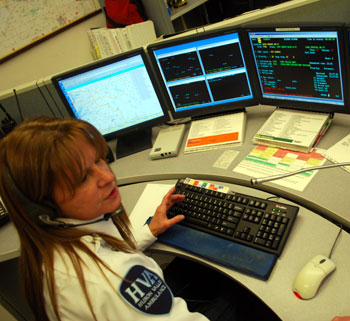A Closer Look at Ann Arbor’s Fire Station Plan
At a work session held by the Ann Arbor city council on March 12, 2012, fire chief Chuck Hubbard presented the city council with a plan to reconfigure the geographic strategy for protecting the city against fires. It would rely on three stations instead of five, which would include re-activating one existing station and closing three.

Map 1. Ann Arbor fire chief Chuck Hubbard's plan is to protect the city from fires with three stations (red helmets): Station 1, Station 2, and Station 5. Closed would be Station 3, Station 6 and Station 4 (gray helmets). Station 2 is currently not used and would need to be re-opened. The light blue area is the part of the city that is reachable by at least four fighters within four minutes. Red dots indicate fire locations over the last decade. (Map is de-skewed from the original one provided by the city, with additional labels by The Chronicle. Image links to higher resolution file.)
The reactivated station would be Station 2 (south), located near Packard and Stadium. Also remaining active would be Station 1 (center), located at Fifth and Huron in downtown Ann Arbor, as well as Station 5 (north), located on Beal off of Plymouth Road in the northern part of the city.
Closed would be Station 6 (located in the southern part of the city, in the Briarwood Mall area), Station 3 (on Jackson, in the western part of the city) and Station 4 (in the eastern part of the city, south of Washtenaw Avenue on Huron Parkway).
Hubbard contends that the proposal will significantly improve response times for most of the geographic area of the city. Hubbard’s guiding metric for response time is the geographic area that is reachable by at least four firefighters in less than four minutes – a “four-in-four” standard. Four firefighters is the minimum number that must be on scene in order to enter a burning building – to conform with an OSHA “two-in/two-out” regulation.
The existing configuration would provide shorter arrival times for a first-arriving vehicle, but would not provide a complement of four firefighters on that vehicle. Shifting to a focus of four-in-four – from the current configuration that optimizes fastest first-arrival – reflects a prioritization of fire protection over emergency medical response.
The council was shown a video at the work session that presented results of an April 2010 study done by the National Institute of Standards and Technology (NIST) that investigated the effect of crew size on task performance. Firefighting responses were studied in controlled conditions by sending four crews at a time to the scene of a structure built for that purpose. The study varied the size of the crews among two-person, three-person, four-person and five-person crews – for a total of 8, 12, 16 and 20 firefighters on scene. The study showed that a responding force composed of four-person crews (16 firefighters on scene) was clearly superior to one composed of three-person crews (12 firefighters on scene) – 25% faster overall.
But with one exception, the new Ann Arbor proposal would not increase the crew size for a given vehicle from the current level (three) to four firefighters. The exception would be for the ladder truck at Station 5, which would have a crew complement of four. At a briefing for the press held earlier in the day, Hubbard described part of the advantage of his proposal as allowing for two trucks to arrive together, departing from the same station, to coordinate their activity at the fire scene. In terms of the study presented in the video, this is called “stagger.”
The NIST study showed an improvement in performance by crews arriving spaced more closely together (close stagger) compared to crews that arrived with longer intervals (far stagger). However, the improvement in firefighting performance due to close stagger was not nearly as large as the improvements based on crew size.
During the council’s discussion, it emerged that the restructuring was not motivated by cost-savings, and that no decrease from the current number of budgeted firefighters – 82 – is expected. The station model does not require formal city council approval, but councilmembers will be considering approval of a recently negotiated contract with the firefighters union at their March 19 meeting. The contract includes operational changes that would allow for more effective deployment of Hubbard’s plan. It provides for firefighters to work more hours, in part by reducing the frequency of a mandatory “code day” when firefighters are not scheduled.
After the jump, we take a look at: (1) some additional maps The Chronicle has created; (2) how the maps fit into the overall response-time picture; and (3) councilmember reaction to Hubbard’s proposal. [Full Story]





